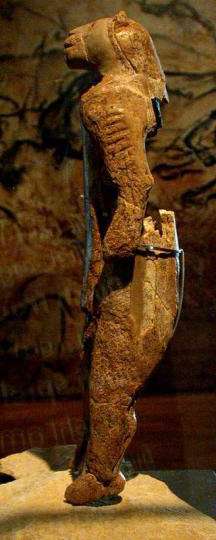Lion-man

The Löwenmensch figurine or Lion-man of the Hohlenstein-Stadel is a very early prehistoric sculpture that was discovered in the Hohlenstein-Stadel, a German cave in 1939. The lion-headed figurine, alternately called (by its German names) Löwenmensch (lion-human) and Löwenfrau (lion-woman), is an ivory sculpture that is both the oldest known zoomorphic (animal-shaped) sculpture in the world, and the oldest known uncontested example of figurative art. The figurine was determined to be about 40,000 years old,[1] by carbon dating of material from the same layer in which the figurine was found. It is associated with the archaeological Aurignacian culture.[2] The figurine is 29.6 cm (11.7 inches) in height, 5.6 cm wide, and 5.9 cm thick. It was carved out of woolly mammoth ivory using a flint stone knife. Seven parallel, transverse, carved gouges are on the left arm. It is now in the museum in Ulm, Germany. By 2015, the ancient figurine was more appropriately being called a lion-headed figurine and identified as Löwenmensch.
History
Most of its pieces were found in 1939 in a cave named Stadel-Höhle im Hohlenstein (Stadel cave in Hohlenstein hill) in the Lonetal (Lone valley) in the Swabian Jura, Germany. Due to the beginning of World War II, it was forgotten and only rediscovered thirty years later. The first reconstruction revealed a humanoid figurine without a head. Between 1997 and 1998, additional pieces of the sculpture were discovered and the head was reassembled and restored.
Initially, the figurine was classified as male by Joachim Hahn. From examination of some additional parts of the sculpture found later, Elisabeth Schmid determined that the figurine was that of a woman with the head of a "Höhlenlöwin" (female European cave lion).[3] Both interpretations currently lack scientific evidence.[3] Male European cave lions often lacked distinctive manes and so the absence of a mane cannot determine categorically that it is a lioness, and a debate about its gender ensued among some people involved in the research and the popular press. The name currently used in German, Löwenmensch—meaning "lion-human"—appropriately, is neutral and will remain relevant if proved one or the other.
Interpretation of the figurine is very difficult. The sculpture shares certain similarities with French cave wall paintings, which also show hybrid creatures. The German sculpture, however, is several thousand years older than the French paintings.
After this artifact was identified, a similar, but smaller, lion-headed human sculpture was found, along with other animal figurines and several flutes, in another cave in the same region of Germany. This leads to the possibility that the Löwenmensch figurine played an important role in the mythology of humans of the early Upper Paleolithic. The nearly one-foot tall sculpture may be seen in the Ulmer Museum in Ulm, Germany, although it may be moved to a new museum of the Paleolithic that is being planned. Following these discoveries, female figurines from approximately the same prehistoric period, such as the Venus of Hohle Fels, have been discovered in the same mountainous area of Germany by an archaeological team led by Nicholas Conard.
See also
References
- ↑ Martin Bailey Ice Age Lion Man is world’s earliest figurative sculpture The Art Newspaper, Jan 31, 2013, accessed Feb 01, 2013
- ↑ http://www-geology.ucdavis.edu/~cowen/HistoryofLife/CH20images.html
- 1 2 Duckeck, Jochen (2008-12-10). "Archäologie: Der Löwenmensch" (in German). Retrieved 2009-05-17.
Joachim Hahn hatte die Figur als männlich betrachtet. Elisabeth Schmid kam zu dem Schluß, dass es sich um die Figur einer Frau mit dem Kopf einer Höhlenlöwin handele.
and Duckeck, Jochen (2008-12-10). "Archaeology: Lionheaded Figurine". Retrieved 2009-05-17.
External links
| Wikimedia Commons has media related to Lion-man. |
- The LionMan Foundation
- Official website of the museum
- The Aurignacian and the Origins of Art in Europe: The Caves and Stone Age Art of the Brenz Region